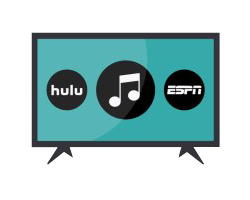harness the power of television
Connected TV (CTV) advertising, also known as over-the-top (OTT) advertising, has grown faster than any other programmatic category in recent years. That is mainly due to the fact that more than 164 million U.S. users accessing video content via connected TV devices and predicted to grow by up to 204.1 million viewers in 2022, it is no surprise that marketers are looking for ways to leverage the channel. Plus the number of Smart TV’s and OTT (over-the-top) devices in households exceeded 1 billion in 2019. In the U.S. alone, more than 50% of the population has a TV-connected device in their home.
CTV advertising can be shown programmatically through most devices and services used for streaming, and they offer greater possibilities for CBD and cannabis businesses than traditional television. It also provides a great way to stand out from your competitors with high-quality commercial video content that reaches your target audience.
What is CTV/OTT?

consoles

sticks

smart tv's
Is it legal to advertise on TV?
The simple answer is yes. Rules are changing all the time and vary state by state. They can even be different on the various platforms and services that serve ads.
While traditional TV ad inventory available through cable or satellite services has remained largely closed to cannabis and CBD advertisers even as legalization has taken hold, CTV’s ad targeting capabilities ensure that these ads can be shown to compliant audiences, and thus CTV/OTT advertising platforms offer a great way for cannabis and CBD brands to reach specific viewers with their compliant ad messaging.
In general, cannabis advertising regulations include the same major stipulations for ad copy and creative across all regions. You can learn more about compliance in our state by state guide.
- No suggestion of health or medical benefits
- No elements that could appeal to children (cartoon characters, etc.)
- No false or misleading statements, including those made about competitors’ products
- No testimonials or endorsements
- No product consumption
- No pricing, potency statements, or promotional offers
- Ads for infused products must state “For Adult Use Only”
CTV vs. Digital Video
CTV inventory is generally available at a higher price point than other forms of digital video ads, and the consumer’s journey advances in a slightly different way.
Whereas digital video ads viewed on websites around the internet include a click-through link that will take the purchaser directly to their corresponding website, connected TV audiences are streaming content on their smart TV, gaming console, or OTT device, so these ads primarily offer brand awareness benefits in a highly engaging and captivating large-screen format.
In general, the main difference between digital video ad creative and CTV ad creative is in the formats accepted and quality required. Note that the same creative can be used for digital video ads and connected TV ads as long as files are 1080p. Programmatic platforms generally support the following CTV ad specifications:
- File type: MP4 (MOV, FLV, and WEBM are not supported). Files must be 1080p.
- File size: 15–50 MB (preferably compressed at 1.5 mbps).
- File tag: VAST (VPAID and MRAID tags are not supported).
- Bitrate: Minimum of 1500 kbps (1.6–3.2 mbps preferred).
- Length: 15 seconds and/or 30 seconds.
How You Can Benefit now
CTV/OTT ads let brands stand out simply by the fact that most cannabis and CBD marketers aren’t using them yet. They offer 100% share-of-voice and an immersive, engaging viewer experience with high-quality video content that allows brands to show rather than make viewers read their story.
“Cord-cutting” is most popular with younger generations, making connected TV ads a great way to reach Gen Z and Millennial demographics in a format that combats ad blindness. With high quality requirements for ads as well as for the CTV content itself, these spots are a way brands can show their professionalism and appear next to other professionally made, brand-safe content.
Since CTV is a subset of video, there is less CTV ad inventory available than there is digital video inventory, but again, fewer brands are vying for those spots, particularly in the cannabis and CBD markets. Still, prices are higher for CTV ads than for digital video, due in part to this more limited availability: In our experience, the cost per thousand impressions (CPMs) for CTV ad placements tend to run about four to five times as much as other digital video CPMs, and high-demand OTT ad providers such as Hulu can cost five to six times as much.
Unlike display, mobile, digital video, and native ads, CTV ads are less focused on driving an immediate action by the viewer: While many ad campaigns through the channels mentioned above are focused on conversion metrics (e.g. purchases, orders, signups, revenue driven, etc.) or engagement metrics (e.g. click-through rate, cost per click, etc.), CTV viewers are not interacting with the content using a mouse, and thus cannot be taken directly to a website to learn more, pre-order, or make a purchase. While all ads, including CTV ads, should include a call-to-action (e.g. ''visit our store’ or ‘ask about our products''), it’s a softer sale than other ad formats use. This makes CTV advertising great for cannabis and CBD brand-building and awareness to leave your competitors behind.


